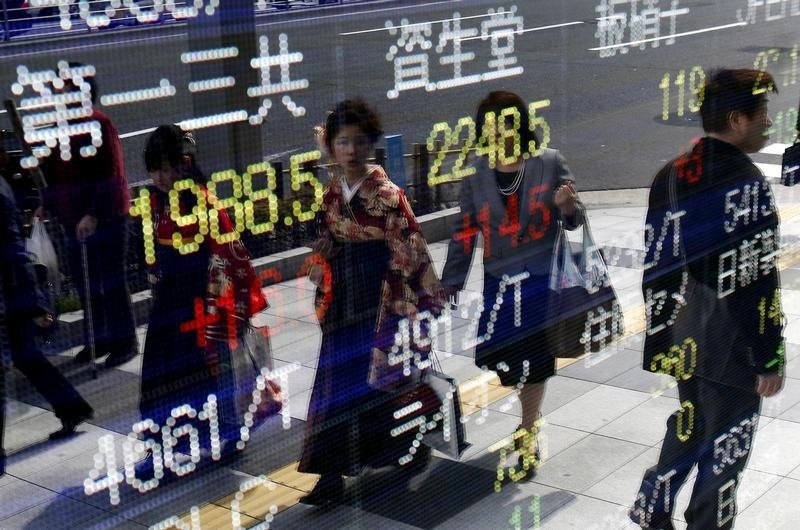* MSCI Asia-Pacific index down 0.45 pct, Nikkei loses 0.35 pct
* Spreadbetters expect European stocks to open slightly higher
* Safe haven bids amid broader risk aversion push up dollar
* Oil bounces modestly after big slide, but market still shaky
* Graphic: World FX rates in 2018 http://tmsnrt.rs/2egbfVh
By Shinichi Saoshiro
TOKYO, Nov 21 (Reuters) - Asian stocks slipped on Wednesday as intensifying concerns about global economic growth gripped financial markets, sending Wall Street shares tumbling and driving the safe haven dollar up from a two-week low.
Spreadbetters expected European stocks to open slightly higher on bargain hunting after several days of losses, with Britain's FTSE .FTSE edging up 0.15 percent, Germany's DAX .GDAXI gaining 0.3 percent and France's CAC .FCHI rising 0.25 percent.
MSCI's broadest index of Asia-Pacific shares outside Japan .MIAPJ0000PUS fell 0.45 percent.
The Shanghai Composite Index .SSEC swerved in and out of the red and was last down 0.05 percent.
Australian stocks .AXJO lost 0.5 percent, South Korea's KOSPI .KS11 retreated 0.4 percent and Japan's Nikkei .N225 fell 0.35 percent.
U.S. stocks sold off for a second day on Tuesday as energy shares dropped with oil prices, while retailers including Target (NYSE:TGT) and Kohl's sank after weak earnings and forecasts, fuelling worries about economic growth. .N
The Nasdaq .IXIC closed at its lowest in more than seven months on Tuesday while the S&P 500 .SPX and Dow .DJI ended at their weakest since late October.
"It is difficult to pinpoint a single factor driving the global risk aversion. Apple (NASDAQ:AAPL) and trade tensions seem to be touted as factors every other day, but it is difficult to blame them for all the woes," said Soichiro Monji, senior economist at Daiwa SB Investments.
"The markets appear to be starting to prepare for a loss of momentum in the global economy, although it is doing quite well at the moment."
The recent downturn in global equities has been led in part by a decline in U.S. technology shares, a group which had helped propel Wall Street's long bull market.
"We are anticipating more weakness in China, and a sharp slowdown in the United States next year. Given the highly-cyclical nature of the information technology (IT) sector, we have been arguing for a while that growth in its earnings would be hit especially hard in these circumstances," wrote economists at Capital Economics.
The dollar index against a basket of six major currencies .DXY was little changed at 96.776 after rallying 0.7 percent overnight, when it pulled away from a two-week trough of 96.042.
Earlier in the week, cautious comments by Federal Reserve officials about the global economic outlook knocked the dollar to two-week troughs as they suggested the central bank could slow the pace of or even end its monetary policy tightening cycle.
The euro was a shade higher at $1.1378 EUR= after sinking 0.75 percent the previous day.
The dollar rose 0.1 percent to 112.87 yen JPY= .
The Australian dollar, sensitive to shifts in risk sentiment, crawled up 0.25 percent to $0.7231 AUD=D4 following a 1 percent slide the previous day.
Commodity currencies such as the Canadian dollar struggled in the wake of tumbling crude prices.
The Canadian dollar was stuck near a five-month low of C$1.3318 per dollar CAD=D4 plumbed on Tuesday, when it shed more than 1 percent.
Oil prices managed to stabilise after Tuesday's slump. But the market remained shaky, with the International Energy Agency (IEA) warning of unprecedented uncertainty in oil markets due to the economic environment and political risk. O/R
U.S. crude futures CLc1 were up 1.45 percent at $54.21 per barrel after retreating roughly 6 percent to $52.77 on Tuesday, its lowest since late October 2017, caught in a broader Wall Street selloff fed by mounting concerns about a slowdown in global economic growth.
Brent crude LCOc1 bounced 1.3 percent to $63.35 per barrel after sliding more than 6 percent on Tuesday, when it plumbed a near one-year low of $61.71. The contracts had reached a four-year high above $86.00 at the start of October.
